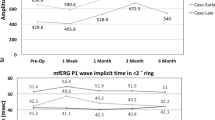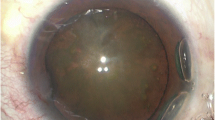Abstract
Siderosis oculi is a severe sequel of retained, iron made, intraocular foreign body. Iron atoms or ions, dissolved from the foreign body, may diffuse to the retina and produce irreversible cellular damage. Therefore, early extraction of an iron foreign body is recommended. When the risks of surgical intervention outweigh the danger of siderosis, the patient is periodically examined in order to detect the initial signs of siderosis. The most commonly used test for quantitative and objective assessment of retinal function is the electroretinogram (ERG). We report here a long term ERG follow-up (about 8 years) of a patient suffering from a unilateral iron intraocular foreign body. The development of siderosis was detected by any of the ERG responses; cone-dominated, rod-dominated or mixed cone-rod responses. However, the degree of the assessed damage varied and strongly depended upon the flash intensity used to elicit the ERG response and upon the ERG wave chosen to assess retinal function. The relationship between the ERG b- and a-waves showed a profound deterioration reflecting a reduction in signal transmission from the photoreceptors to the inner nuclear layer. These findings suggested that iron toxicity produced more damage to the inner retina than to the outer retina.
Similar content being viewed by others
References
Masciulli, L, Anderson, DR, Charles, S. Experimental ocular siderosis in the squirrel monkey. Am J Ophthalmol 1972; 74: 638–61.
Declercq, SS, Meredith, PCA, Rosenthal, AR. Experimental siderosis in the rabbit: correlation between electroretinography and histopathology. Arch Ophthalmol 1977; 95: 1051–58.
Armington, JC. The Electroretinogram. New York: Academic Press, 1974.
Berson, EL. Electrical phenomena in the retina. In: Moses, RA, ed. Adler's Physiology of the Eye. St Louis: Mosby, 1981: 466.
Knave, B. Electroretinography in eyes with retained intraocular metallic foreign bodies. Acta Ophthalmol Suppl 1969; 100: 2–63.
Knave, B. The ERG and ophthalmological changes in experimental metallosis in the rabbit, I: Effects of iron particles. Acta Ophthalmol 1970; 48: 136–158.
Sieving, PA, Fishman, GA, Alexander, KR, Goldberg, MF. Early receptor potential measurements in human ocular siderosis. Arch Ophthalmol 1983; 101: 1716–20.
Duke-Elder, S, MacFaul, PA. Injuries: I. Mechanical injuries. In Duke-Elder, ed. Systems of Ophthalmology. St. Louis: Mosby, 1972: 525–44.
Perlman, I. Relationship between the amplitudes of the b-wave and the a-wave as a useful index for evaluating the electroretinogram. Br J Ophthalmol 1983; 67: 443–48.
Perlman, I, Gdal-on, M, Miller, B, Zonis, S. Retinal function of the diabetic retina after argon laser photocoagulation assessed electroretinographically. Br J Ophthalmol 1985; 69: 240–46.
Sandberg, MA, Rosen, JB, Berson, EL. Cone and rod function in vitamin A deficiency with chronic alcoholism and in retinitis pigmentosa. Am J Ophthalmol 1977; 84: 658–64.
Perlman, I, Barzilai, D, Haim, T, Schramek, A. Night vision in a case of vitamin A deficiency due to malabsorption. Br J Ophthalmol 1983; 67: 37–42.
Cicerone, CM. Cones survive rods in the light-damaged eye of the albino rats. Science 1976; 194: 1183–85.
Author information
Authors and Affiliations
Rights and permissions
About this article
Cite this article
Schechner, R., Miller, B., Merksamer, E. et al. A long term follow up of ocular siderosis: Quantitative assessment of the electroretinogram. Doc Ophthalmol 76, 231–240 (1990). https://doi.org/10.1007/BF00142682
Accepted:
Issue Date:
DOI: https://doi.org/10.1007/BF00142682




